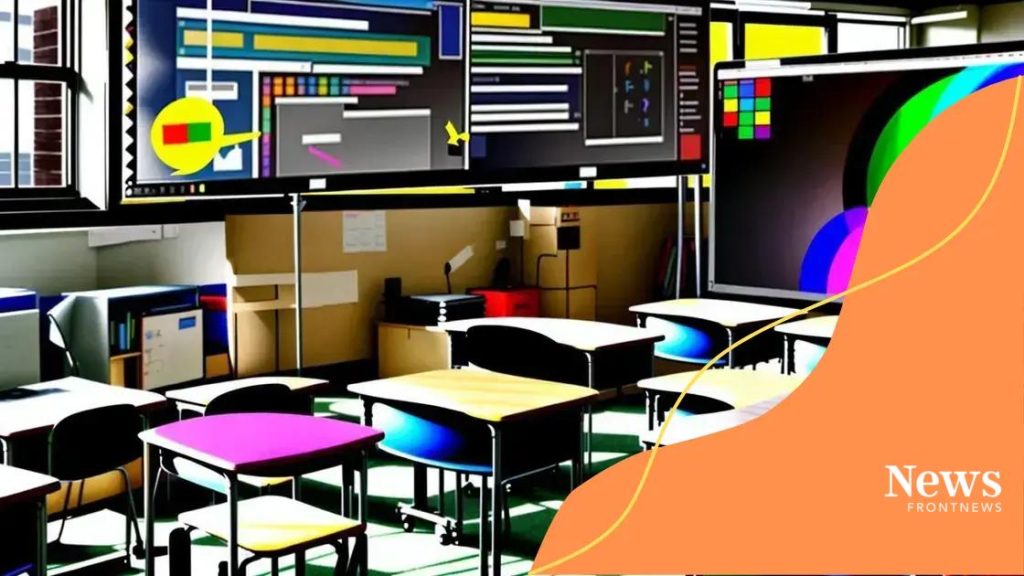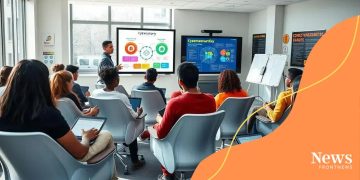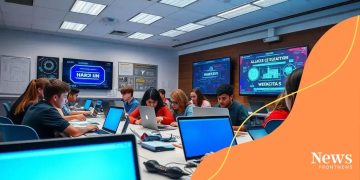Curriculum overhaul: transforming education for the future

A curriculum overhaul involves updating educational content and methods to better align with current technology and societal needs, enhancing student engagement and preparing them for future challenges.
Curriculum overhaul is becoming increasingly vital as educational needs evolve. Have you ever wondered how we can better prepare students for tomorrow’s challenges? Let’s dive into the core aspects of transforming our education systems.
Understanding the need for curriculum overhaul
Understanding the need for a curriculum overhaul is crucial in today’s education landscape. As society evolves, so do the skills and knowledge students need to thrive. This transformative process is not just about updating books; it addresses necessary changes in teaching methods and learning goals.
Why Change is Necessary
There are several reasons for rethinking our educational curricula. First, advancements in technology are reshaping how students engage with information. Schools must adapt to these changes to remain relevant.
- Incorporation of digital tools and resources
- Preparation for workforce demands
- Enhancing critical thinking and problem-solving skills
Moreover, addressing diverse student needs is vital for effective learning. Modern classrooms now include students from various backgrounds with unique challenges. An updated curriculum can help in tailoring education to fit all learners.
Benefits of a Modern Curriculum
Schools implementing a curriculum overhaul find numerous benefits. These changes promote student engagement and retention. By introducing relevant topics that captivate interest, educators can inspire a love for learning.
- Increased student motivation
- Real-world applications of knowledge
- Improved academic performance
A dynamic curriculum prepares students not only academically but also socially and emotionally. As students learn in a collaborative environment, they develop important interpersonal skills that are essential for their future. Flexibility and creativity become integral parts of learning, fostering an adaptable mindset.
Key elements of an effective curriculum
Key elements of an effective curriculum are essential for fostering a learning environment that promotes student growth. A well-structured curriculum not only delivers knowledge but also engages students in meaningful ways. Understanding these elements helps educators design courses that resonate with learners.
Clear Learning Objectives
Establishing clear learning objectives is a fundamental aspect of an effective curriculum. These goals guide what students should accomplish by the end of the course. Well-defined objectives help teachers measure progress and ensure that learners stay on track.
- Specific and measurable goals
- Aligned with educational standards
- Relevant to students’ needs and interests
When objectives are clear, students know what is expected of them. This clarity fosters motivation and accountability, making instructional strategies more effective.
Content Relevance
Another vital element is the relevance of the content. An engaging curriculum reflects current events, trends, and technologies that impact students’ lives. When students see the connection between their studies and the real world, they are more likely to invest their time and effort.
- Integration of current events
- Connections to real-world applications
- Incorporation of student interests
Moreover, content should not only focus on traditional subjects but also include skills like critical thinking and collaboration. These skills prepare students for future challenges and workplace demands.
Lastly, assessment strategies must align with the curriculum. Ongoing feedback is crucial for both students and teachers. It helps identify areas of improvement and affirm achievements. A balance of formative and summative assessments ensures that learning is assessed in varied ways, providing a more comprehensive view of student understanding.
Steps to implement a curriculum overhaul

Implementing a successful curriculum overhaul involves a series of strategic steps. Each step is important to ensure that changes are beneficial and sustainable for the learning environment. Begin by forming a dedicated team to lead the change and gather various perspectives.
Assessment of Current Curriculum
The first step is to assess the existing curriculum comprehensively. This involves reviewing current lessons, materials, and teaching strategies. Understanding what works and what does not will provide insight into areas needing reform.
- Conduct surveys with teachers and students
- Analyze student performance data
- Identify gaps in knowledge and skills
By gathering this information, teams can pinpoint which aspects require strengthening or complete rethinking. This clarity ensures that all efforts align with improving student learning outcomes.
Engagement of Stakeholders
Engaging stakeholders is crucial for any curricular changes. Teachers, administrators, parents, and community members can offer valuable feedback and support. Involvement fosters a sense of ownership and collaboration.
- Hold focus groups and discussions
- Share the vision and goals of the overhaul
- Encourage input on new ideas and methods
When everyone is on board, the transition becomes smoother, and resistance diminishes. This collective approach leads to a richer curriculum that reflects the community’s needs.
Development of New Materials
Once the assessment is complete and input is gathered, the next step is to develop new materials. This involves creating or sourcing resources that align with the revised curriculum goals. Innovative materials can enhance engagement and understanding.
During this phase, it’s important to emphasize the integration of technology and hands-on learning experiences. These elements can help students connect with the material in meaningful ways.
Finally, implement a professional development plan for educators. Providing training on new resources and teaching strategies ensures that teachers feel confident and prepared to deliver the revamped curriculum effectively.
Challenges in curriculum design and implementation
Challenges in curriculum design and implementation can significantly impact the effectiveness of educational reforms. A thorough understanding of these obstacles helps organizations navigate them successfully, ensuring that the new curriculum meets the needs of all students.
Resistance to Change
One major challenge is resistance to change among staff, students, and parents. Many individuals may feel comfortable with the existing curriculum and be hesitant to adopt new methods. This reluctance can lead to diminished enthusiasm during the implementation phase.
- Concerns about the unknown impacts of changes
- Fear of increased workload or complexity
- Lack of understanding of the benefits of the new approach
To address this challenge, providing clear communication about the reasons for the overhaul is essential. Educators and stakeholders should be involved in discussions to help them feel ownership of the changes.
Resource Constraints
Resource constraints often pose significant hurdles. Many schools operate under tight budgets, making it difficult to secure necessary materials, technology, or training for teachers. Limited resources can hinder the successful implementation of a new curriculum.
- Inadequate funding for new materials
- Insufficient training opportunities for teachers
- Lack of time to develop and adjust lesson plans
To overcome this obstacle, educational leaders must prioritize funding and create a clear plan for resource allocation. Seeking community partnerships and grants can also enhance the budget for the curriculum overhaul.
Alignment with Standards
Another significant hurdle is aligning the new curriculum with state and national educational standards. Ensuring compliance with these guidelines while meeting the diverse needs of students can be complex. This misalignment can result in confusion and frustration.
Curriculum developers must continuously evaluate how well their new materials align with established standards. Regular feedback from educators can aid in making necessary adjustments, ensuring that legal and educational expectations are met.
Ultimately, overcoming these challenges requires cooperation, effective communication, and strategic planning. When stakeholders work together, the chances of a successful curriculum implementation increase, significantly benefiting student learning outcomes.
Future trends in curriculum development
Future trends in curriculum development are shaping the way education is delivered. As technology advances, the educational landscape evolves, prompting new methods and ideas. Staying informed about these trends can help educators and institutions adapt to better meet students’ needs.
Integration of Technology
One major trend is the increased integration of technology in the classroom. Digital tools and platforms are becoming essential for enhancing learning experiences. Schools are adopting tools like learning management systems, interactive whiteboards, and educational apps.
- Online resources for research and assignments
- Virtual reality for immersive learning experiences
- Adaptive learning technologies to personalize education
These innovations help engage students and provide them with skills needed for a technology-driven world. Teachers can create interactive lessons that cater to different learning styles, making education more effective.
Focus on Social-Emotional Learning
Another significant shift is the focus on social-emotional learning (SEL). This approach emphasizes developing emotional intelligence and interpersonal skills in students. Educators recognize that nurturing these skills can positively impact student well-being and academic performance.
- Implementing SEL programs in classrooms
- Encouraging collaboration and teamwork among students
- Building resilience and problem-solving skills
By incorporating SEL, schools create a more supportive learning environment. Students learn to manage their emotions and build healthy relationships, essential skills for their future.
Project-Based and Experiential Learning
Project-based and experiential learning are also gaining traction. These approaches allow students to engage in real-world problem-solving through hands-on projects. This method promotes deeper understanding and retention of knowledge.
Students work collaboratively on projects that have genuine relevance to their lives. This learning style helps them develop critical thinking, teamwork, and practical skills that are vital for success in college and careers.
As we look ahead, understanding these curriculum development trends is crucial for educators. Adapting to these changes will better prepare students for the challenges of tomorrow while promoting a more dynamic and engaging learning experience.
FAQ – Frequently Asked Questions about Curriculum Overhaul
What are the main benefits of a curriculum overhaul?
A curriculum overhaul enhances student engagement, prepares them for real-world challenges, and ensures the content is relevant to current trends and technologies.
How can technology be integrated into the curriculum?
Technology can be integrated through digital tools like learning management systems, educational apps, and interactive resources that enhance teaching and learning.
What is social-emotional learning and why is it important?
Social-emotional learning focuses on developing emotional intelligence and interpersonal skills, which are crucial for students’ well-being and academic success.
How can teachers overcome resistance to curriculum changes?
Teachers can overcome resistance by involving stakeholders in the process, clearly communicating the benefits, and providing support and training during the transition.





